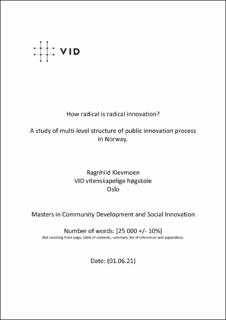| dc.description.abstract | This thesis is about innovation in the public sector in Norway, using discourse analysis to analyze documents and texts from the Government (Ministry of Local Government and Development, KMD), and KS's program; Partnership for radical innovation, to get a better understanding of how radical innovation are understood and facilitated. In addition, I conducted interviews with people who work in different levels in the public sector administration (national, regional and municipal). Based on the understanding of major societal challenges related to social, environmental and economic issues, radical innovation is promoted as one of the answers to more effectively meet these grand challenges. The research questions are related to how radical innovation is understood and applied in the public discourse and are related to two dimensions; newness and governance patterns. Newness is analyzed in relation to two categories taken from theory, incremental and disruptive innovation. Governance patterns are analyzed according to categories derived from a mix of theory and empirical data. From theory I used four categories given as four governance models. From empirical data a category emerged, which was not so easily placed in the category of incremental or disruptive. They went beyond disruptive change in product or process. These findings formed the basis for an understanding of innovations fundamentally challenging governance systems and their economic, social and environmental dimensions. Theory from social innovation and innovation in the public sector was used to study the sampled data. The thesis does not conclude what radical innovation is, or a simple answer to how the term is understood in the public discourse in Norway. A consistent finding at all levels the study examined is a vague approach to how radical innovation differs from innovation in the public sector. It seems that the main approach is to understand radical innovations related to disruptive innovations of products, services and processes. But also to a degree in what ways radical innovation can challenge basic systems and governance systems and their economic, social and environmental dimensions. One relevant question when it comes to innovation I public sector is; can radical innovation be called radical if not simultaneously addressing system level, acknowledging and III confronting political and power issues across societies? The danger otherwise, is as Unger mention, that social innovation is absorbed into existing systems – tamed into irrelevance. | en_US |
